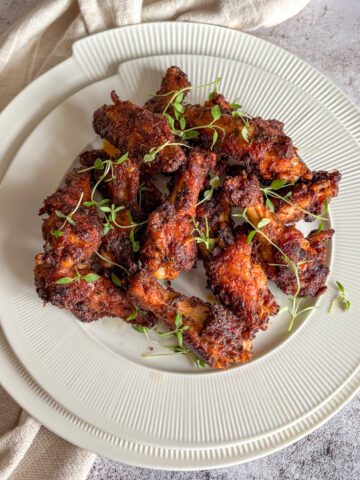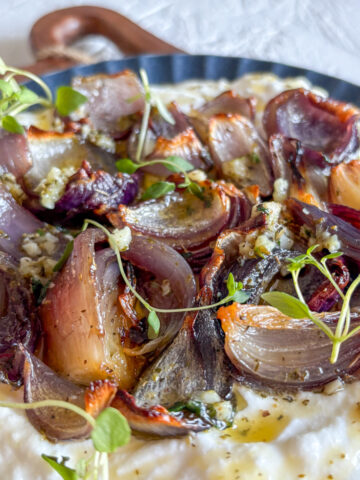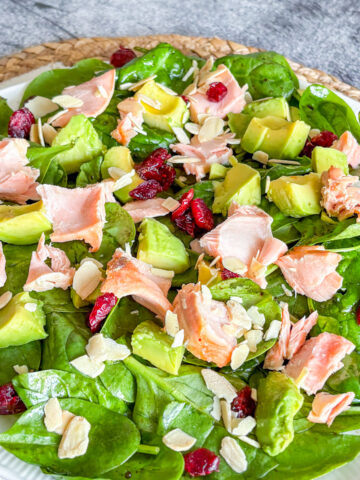Vegetable Caviar is one of those simple yet flavour-packed dishes that I never get tired of making. Made with courgettes, peppers, carrots, and onions, it has a naturally sweet and savoury taste that gets even better the next day. Whether enjoyed as a chunky side dish, a smooth dip, or a spread on crusty bread, this classic recipe is a delicious way to savour fresh vegetables all year round.
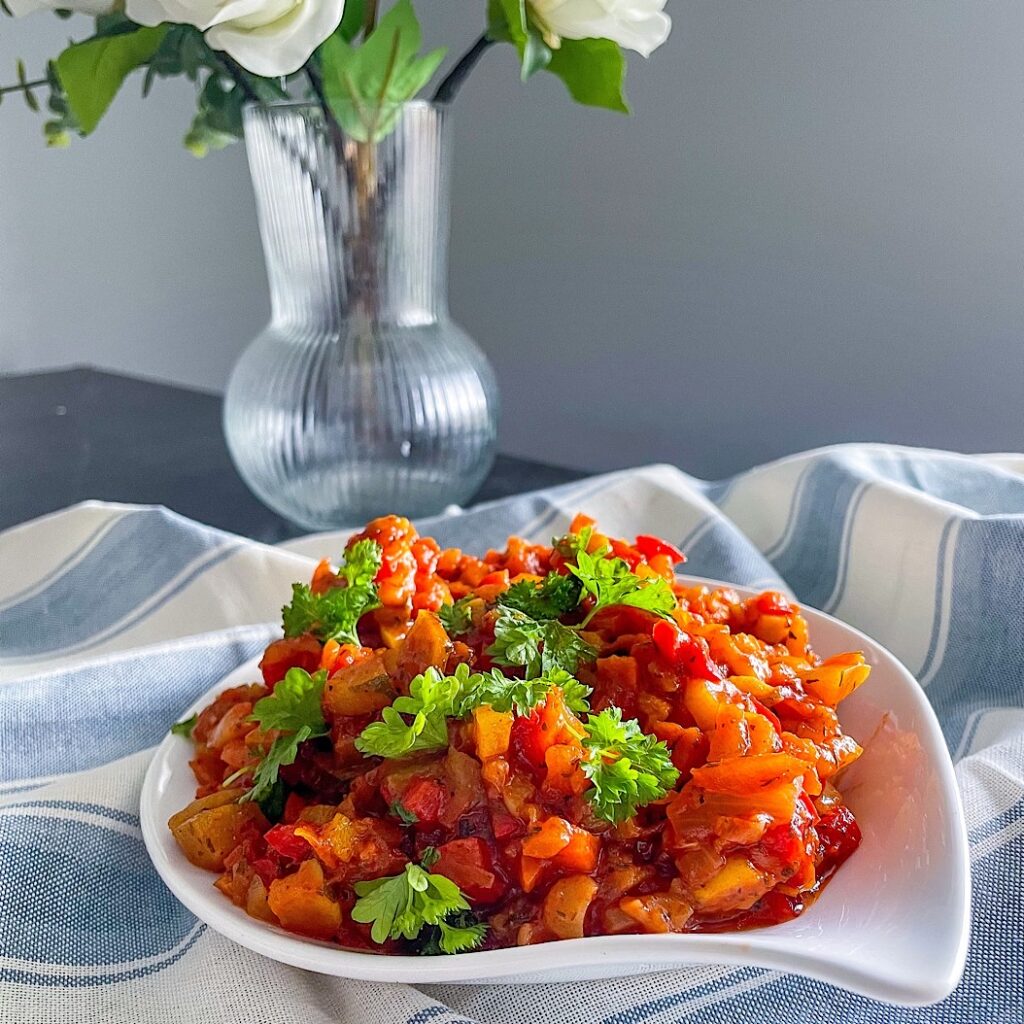
Jump to:
A Staple from Soviet Times to Modern Kitchens
Growing up, I remember how popular vegetable caviar was in many homes. Vegetable caviar has been a part of Russian cuisine since pre-revolutionary times when people used slow-cooking methods (think "печка" - slowly cooking in hot stove) to preserve seasonal vegetables. However, it became especially popular in Soviet households as an affordable and practical way to make use of summer harvests. Families would cook large batches, seal them in jars (закрутки), and store them for the harsh winter months when fresh produce was scarce. Vinegar helped extend its shelf life, and sterilising the jars ensured the caviar stayed good for months.
In the 1990s, when times were tough for many, this dish became a lifesaver. People relied on vegetables from their дача (summerhouse gardens), and vegetable caviar was a budget-friendly way to make those homegrown crops last.
These days, the economic situation for many families has improved, and fresh vegetables are readily available in supermarkets. You can even buy ready-made vegetable caviar in jars! But no matter how convenient that is, I still believe homemade is the best—it’s richer in flavour, and you can customise it just the way you like.
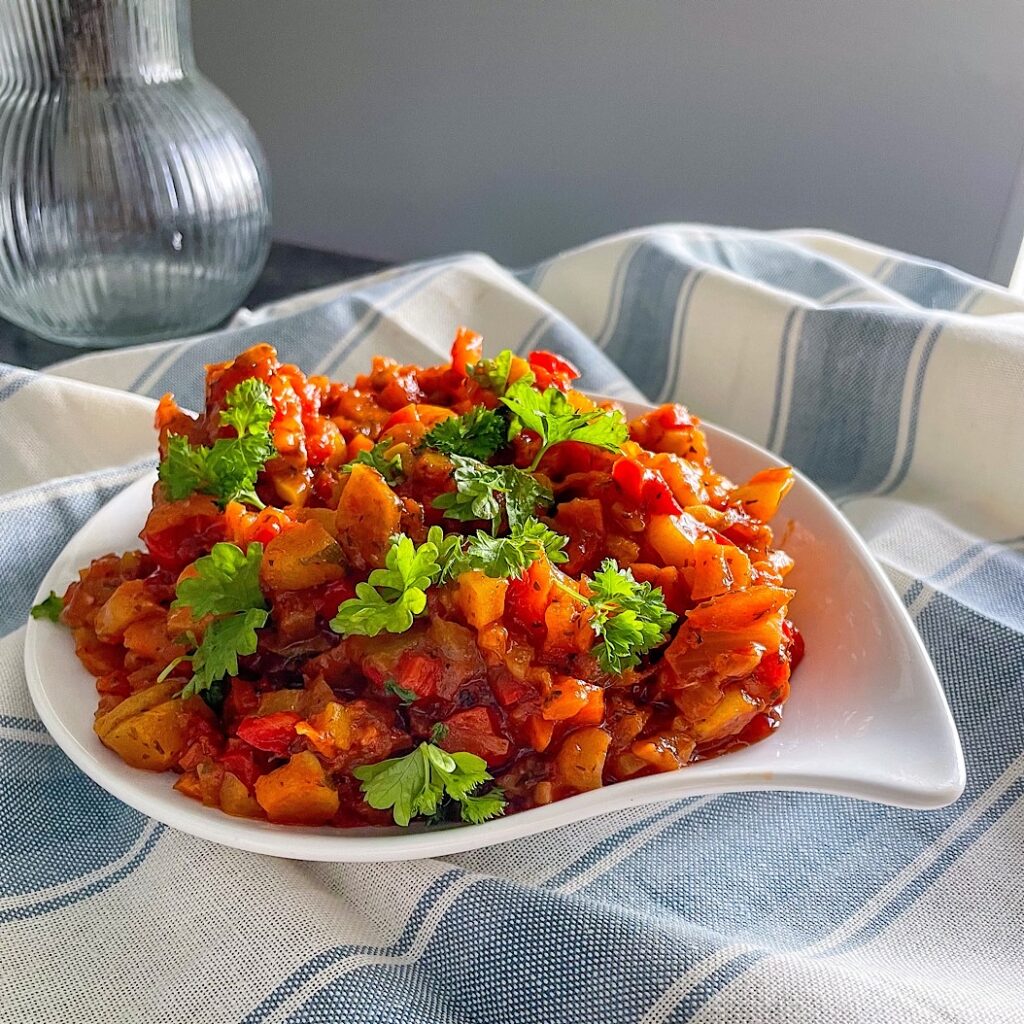
Ingredients
Vegetable caviar is all about using simple vegetables in a way that brings out their best qualities. Each ingredient in this dish has a purpose—whether it’s for flavour, texture, colour, or balance, nothing here is accidental.
- Courgettes – Mild in flavour and rich in moisture, courgettes break down beautifully during cooking and form the soft, creamy base of the caviar.
- Red Peppers – Naturally sweet and aromatic, they add depth, vibrant colour, and balance the earthy vegetables.
- Onions – Sautéed until golden, onions bring a mellow sweetness and form the savoury backbone of the dish.
- Carrots – They contribute a natural sweetness and help thicken the mixture as they cook down.
- Garlic – Adds a bold, aromatic kick that cuts through the sweetness and deepens the overall flavour.
- Chilli Pepper – Offers a gentle heat and brightness, lifting the dish without overwhelming the other ingredients.
- Tomato Paste – Provides richness, acidity, and umami depth, while also helping to bring all the vegetables together.
- Rapeseed Oil – A neutral oil perfect for sautéing, allowing the vegetables’ flavours to shine without interference.
- Salt and Pepper – Essential seasonings to enhance and balance the natural flavours in the dish.
- White Vinegar – Brings a subtle tang and balances the sweetness; also helps preserve the caviar if storing longer.
- Sugar – A touch of sugar rounds out the acidity from the tomato paste and vinegar, bringing harmony to the dish.
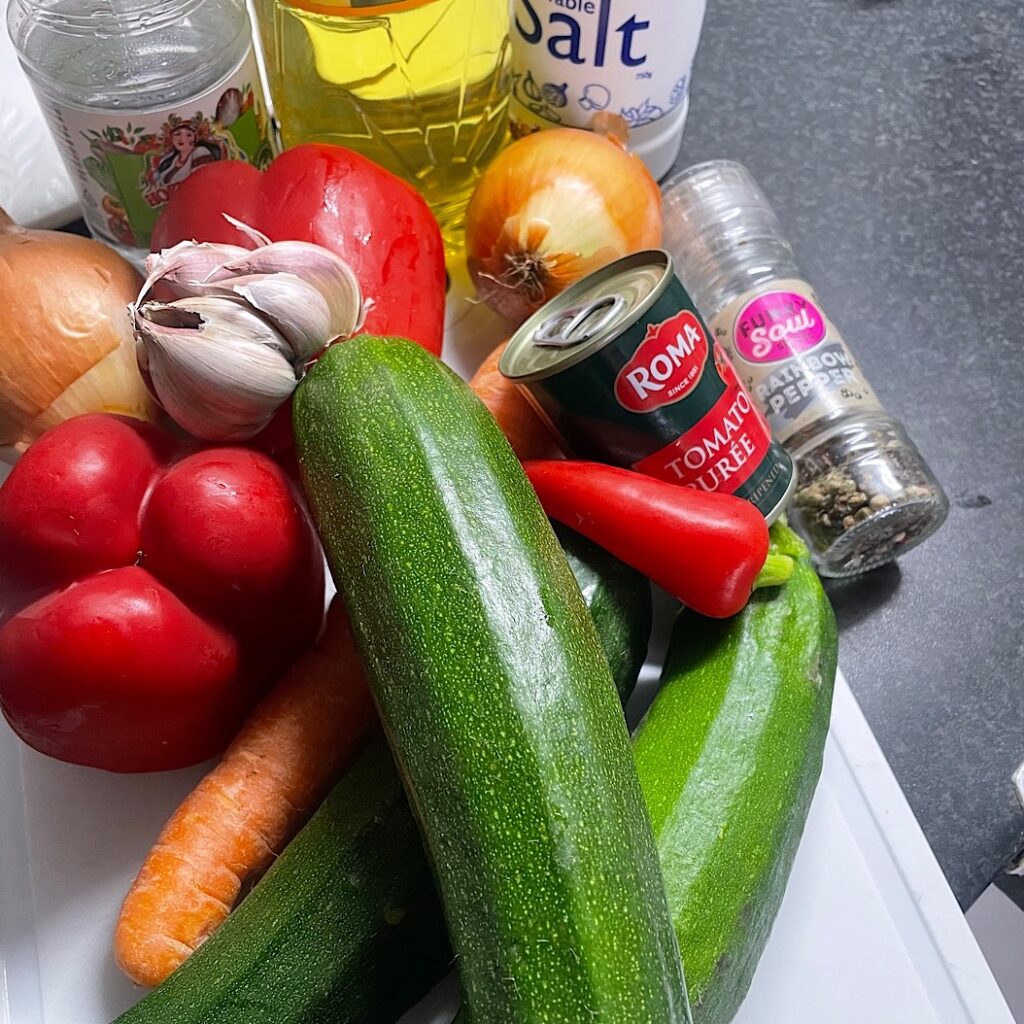
How I Cook Vegetable Caviar
Making vegetable caviar is all about patience and layering flavours slowly. With a bit of chopping and a good simmer, you’ll have a rich, comforting dish ready to enjoy warm or cold.
- Prepare the vegetables – Peel the carrots and onions, deseed the peppers, and chop all the vegetables into small, evenly sized cubes. If you plan to blend the caviar later, you can keep the pieces slightly larger. Finely chop the garlic and chilli pepper (if using).
- Sauté in stages – Heat rapeseed oil in a large skillet. Start by sautéing the carrots and onions for 5 minutes, then add the chopped peppers and cook for another 5 minutes, stirring occasionally.
- Add courgettes and simmer – Stir in the courgettes and let them cook for 10 minutes until they begin to soften. Add the tomato paste, garlic, chilli, salt, and pepper, then cover and simmer on low heat for 45 minutes, stirring occasionally.
- Finish and balance – Once the vegetables are fully softened and combined, stir in the vinegar (if using) and sprinkle in the sugar to balance the acidity. Mix well, let it cool slightly, and serve as preferred—chunky or blended.
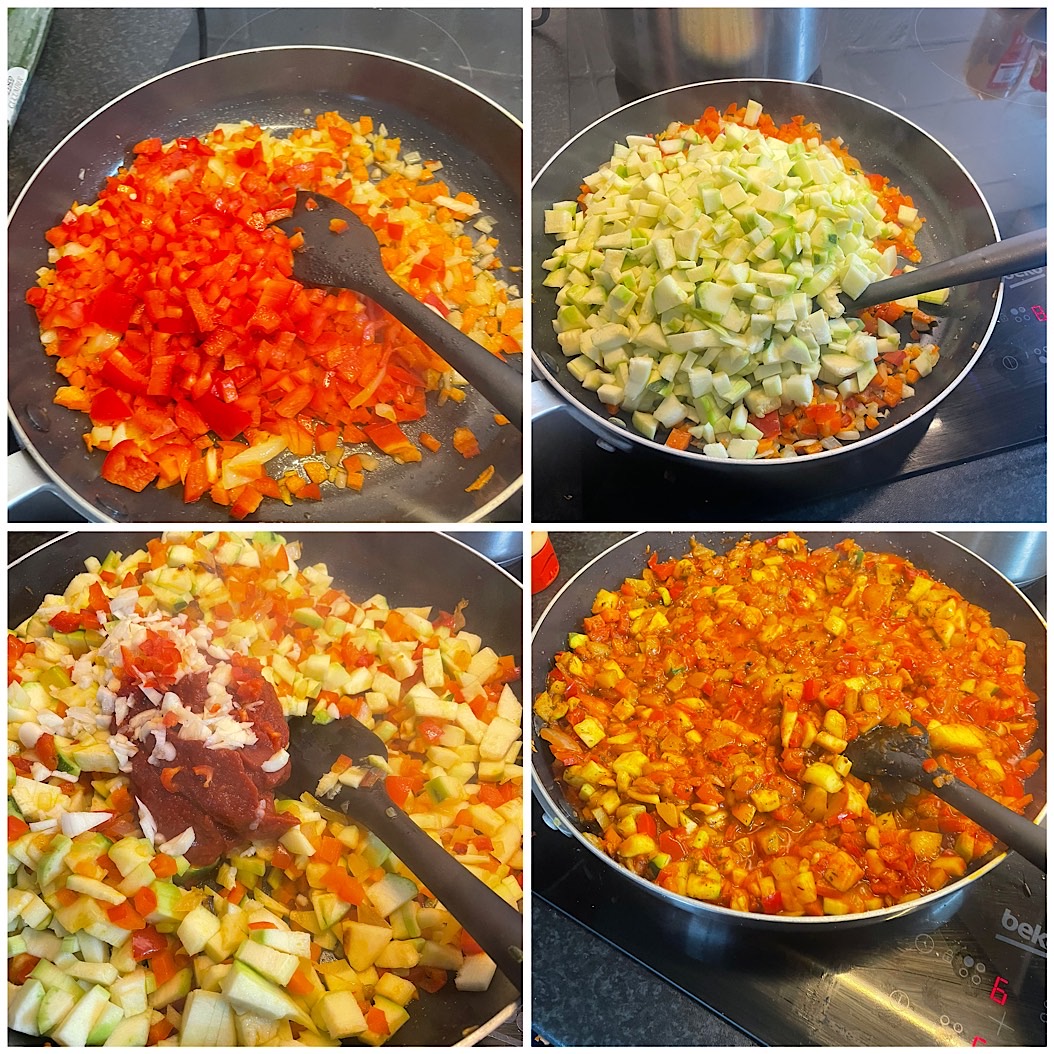
8 Useful Tips for Making Vegetable Caviar
- Use ripe vegetables – Riper courgettes and peppers have more flavour and a better texture for slow cooking.
- Uniform chopping matters – Chop the vegetables into similar-sized pieces to ensure even cooking, especially if you're keeping the dish chunky.
- Don’t rush the sauté – Allow enough time to sauté the onions and carrots well—they form the flavour base of the dish.
- Low and slow is best – Simmering the vegetables on low heat for 45 minutes allows the flavours to deepen and meld together.
- Taste as you go – Season gradually with salt and pepper and adjust to taste before serving.
- Optional vinegar, but recommended – Vinegar not only adds brightness but also enhances preservation if you plan to store it longer.
- Sugar for balance – Even a small amount of sugar makes a difference in rounding out acidity from the tomato paste and vinegar.
- Better the next day – Like many stews and spreads, the flavour improves after resting overnight in the fridge.
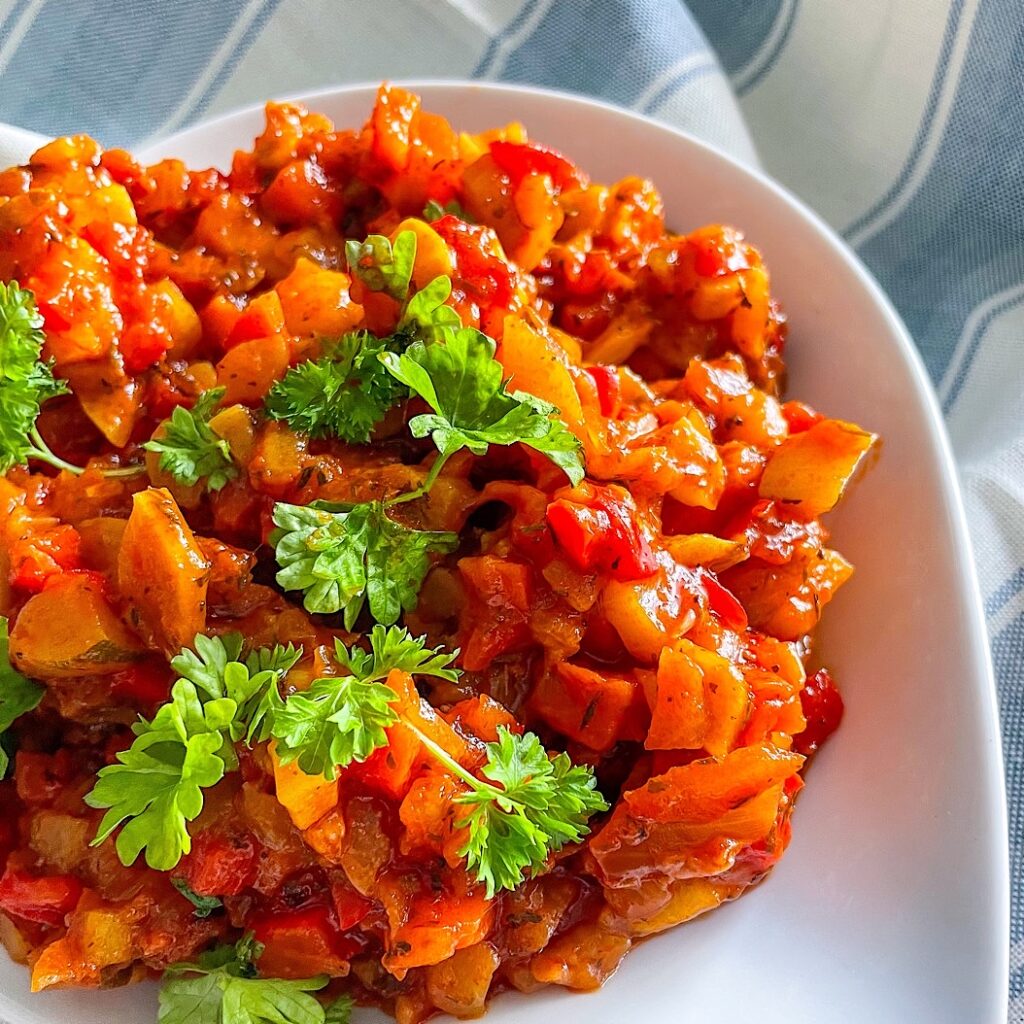
Serving Vegetable Caviar: Dip/Spread or Side Dish?
There are two ways to serve vegetable caviar, and I honestly love both:
- Blended into a dip – When I want a smooth, creamy texture, I blend it. It’s amazing on rye bread, crackers, or even as a dip for crisps.
- Kept chunky – Most of the time, I prefer it this way because I love the texture of the soft, stewed vegetables. It’s perfect as a side dish with boiled potatoes or grilled meats, or just as a simple appetiser.
How to Store Vegetable Cavir
Back in the day, people would seal this in jars to keep it all winter. I don’t usually make huge batches, so I just store it in an airtight container in the fridge—it stays fresh for about 5 days.
If you’ve never tried vegetable caviar before, I highly recommend giving it a go! Whether you blend it into a dip or keep it chunky, it’s a fantastic way to enjoy fresh vegetables all year round.
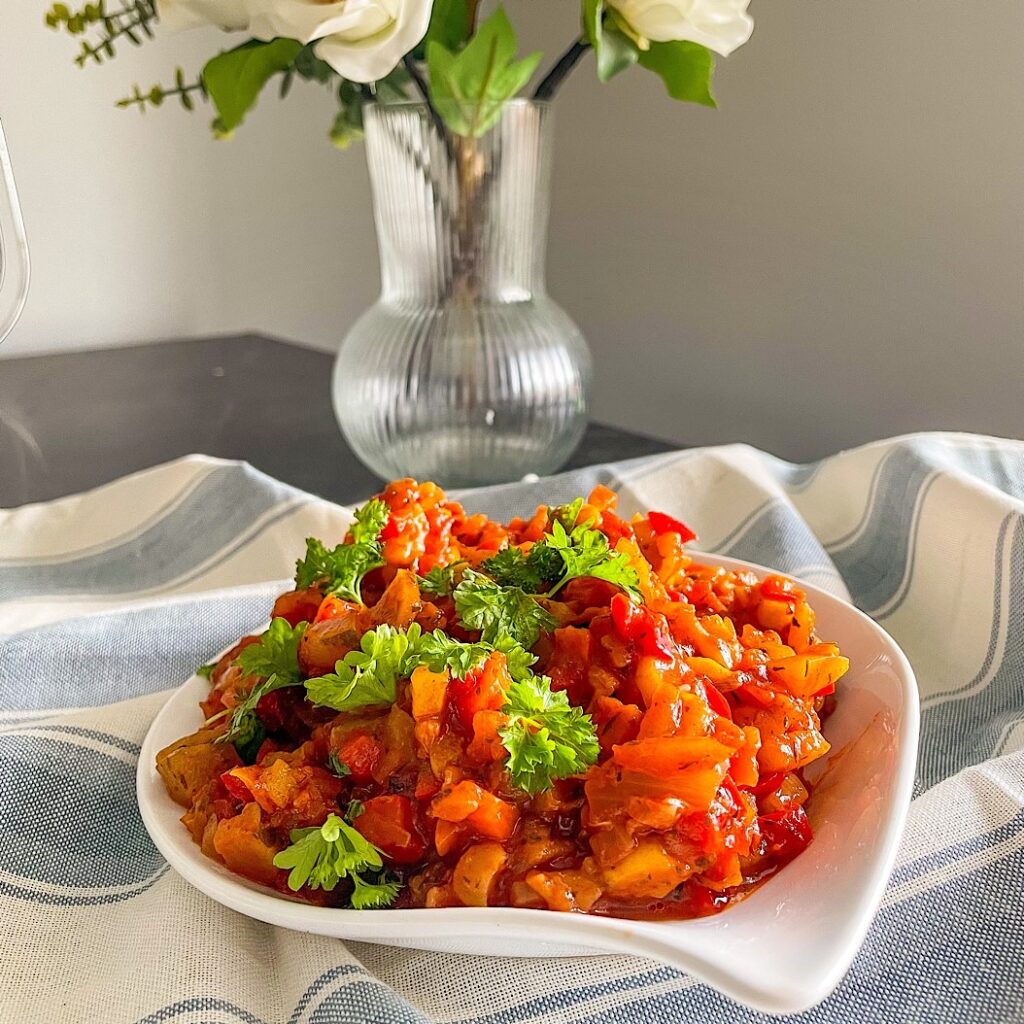
Do I have to use vinegar?
No, it's optional. But a small splash brightens the dish and balances the sweetness—especially useful if you're storing it longer.
Can I use olive oil instead of rapeseed oil?
A9: You can, but choose a mild olive oil so it doesn’t overpower the vegetable flavours.
Is this dish vegan?
Yes! All ingredients are plant-based, making it a great option for vegan and vegetarian diets.
Can I add other vegetables?
Definitely. Aubergines, celery, or parsnips can work well, but they may change the flavour slightly.
Can I make vegetable caviar without tomato paste?
Yes, but tomato paste adds depth and richness. You can substitute with fresh tomatoes, though the consistency may be thinner.
Vegetable Caviar
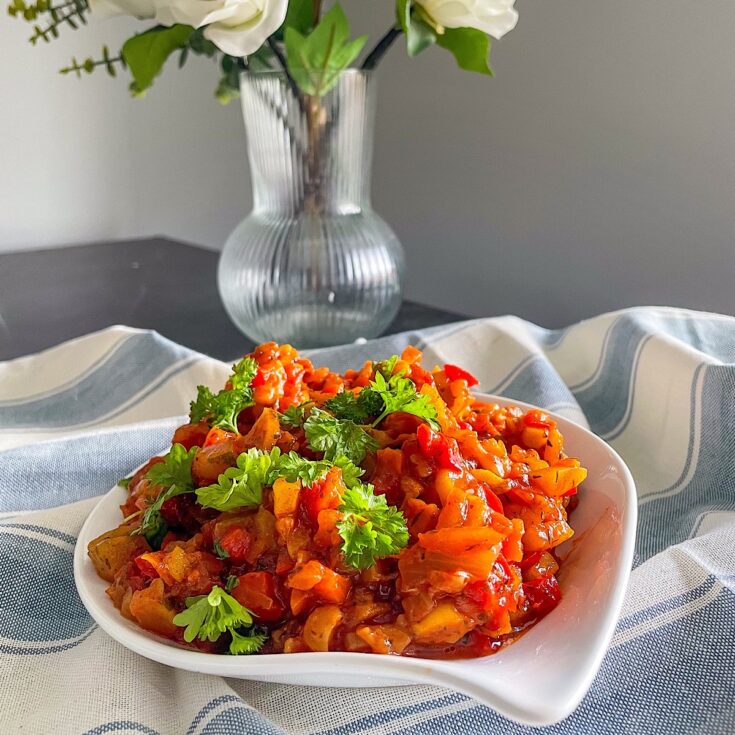
Vegetable Caviar is a flavourful spread made with courgettes, peppers, carrots, and onions. Enjoy it chunky or blended as a dip or side dish!
Ingredients
- 3 zucchinis (courgettes), diced
- 2 red peppers, deseeded and chopped
- 2 onions, finely chopped
- 2 carrots, peeled and diced
- 1 garlic head, peeled and minced
- ½ chilli pepper, finely chopped (optional, for a spicy kick)
- 3–4 tablespoon tomato paste
- Salt and pepper, to taste
- Rapeseed oil, for frying
- 1 tablespoon white vinegar (optional)
- ½ teaspoon sugar
Instructions
- Prepare the vegetables – Peel the carrots and onions. Deseed the peppers and chop all vegetables into small, evenly sized cubes. If you are planning to blend the caviar, then you can make bigger pieces. Finely chop the garlic and chilli (if using).
- Sauté the vegetables – Heat oil in a large skillet. Add the carrots and onions first, sautéing for 5 minutes. Then, stir in the peppers and cook for another 5 minutes.
- Add courgettes – Stir in the diced courgettes and cook for 10 minutes, stirring occasionally.
- Simmer with seasoning – Add the tomato paste, garlic, chilli, salt, and pepper. Cover with a lid and let the mixture cook on low heat for 45 minutes, stirring occasionally.
- Finish the dish – If using vinegar, add it at the end. Sprinkle sugar to balance the acidity. Stir well and remove from heat.
- Cool and serve – Let the vegetable caviar cool before serving. Enjoy it as a spread on bread, a dip, or a side dish.


